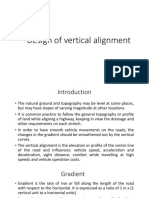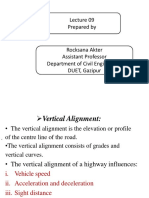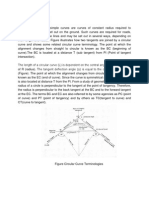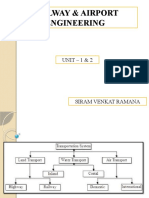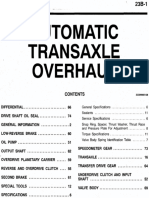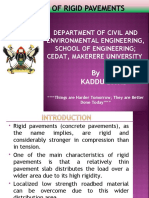Rohini 45758040124
Rohini 45758040124
Uploaded by
vellepanti2001Copyright:
Available Formats
Rohini 45758040124
Rohini 45758040124
Uploaded by
vellepanti2001Original Title
Copyright
Available Formats
Share this document
Did you find this document useful?
Is this content inappropriate?
Copyright:
Available Formats
Rohini 45758040124
Rohini 45758040124
Uploaded by
vellepanti2001Copyright:
Available Formats
ROHINI COLLEGE OF ENGINEERING & TECHNOLOGY
DESIGN OF VERTICAL ALIGNMENT
INTRODUCTION
The natural ground or the topography may be level at some places, but may have slopesof varying
magnitudes at other locations. While aligning a highway it is the common practice to follow the general
topography or profile of the land, keeping in view the drainage and otherrequirements on each stretch.
This is particularly with a view to minimise deep cuttings and very high embankments. Hence the
vertical profile of a road would have level stretches as wellas slopes or grades.
In order to have smooth vehicle movements on the roads, the changes in the gradient should be
smoothened out by the vertical curves. The vertical alignment is the elevation or profile of the centre
line of the road. The vertical alignment consists of grades and vertical curves.
The vertical alignment of a highway influences
1) Vehicle Speed
2) Acceleration and Deceleration
3) Stopping Distance
4) Sight Distance
5) Comfort While Travelling at High Speeds
6) Vehicle Operation Cost.
Gradient
Gradient is the rate of rise or fall along the length of the road with respect to the horizontal. It
is expressed as a ratio of 1 in x (1 vertical unit to x horizontal units). The gradientis also expressed as
percentages such as n%, the slope being n vertical units to 100 horizontal units
Types of gradient
a) Ruling Gradient
b) Limiting Gradient
c) Exceptional Gradient
d) Minimum Gradient
Ruling gradient
The ruling gradient or the design gradient is the maximum gradient with which the designer
attempts to design the vertical profile of the road. This depends on the terrain, lengthof the grade, speed,
pulling power of the vehicle and the presence of the horizontal curve. In plain terrain, it may be possible
to provide at gradients, but in hilly terrain it is not economicaland sometimes not possible also.
CE3305 HIGHWAY AND RAILWAYENGINEERING ASWINI.R.K AP/CIVIL
ROHINI COLLEGE OF ENGINEERING & TECHNOLOGY
The IRC has recommended ruling gradient values of
a) 1 in 30 on plain and rolling terrain
b) 1 in 20 on mountainous terrain
c) 1 in 16.7 on steep terrain.
Limiting gradient
Where topography of a place compels adopting steeper gradient than the ruling gradient,
'limiting gradient' is used in view of enormous increase in cost in constructing roads with gentler
gradients. However, the length of continuous grade line steeper than ruling gradient should be limited.
On rolling terrain and on hill roads, it may be frequently necessaryto exceed ruling gradient and adopt
limiting gradient, but care should be taken to separate suchstretches of steep gradients by providing
either a level road or a road with easier grade.
Exceptional gradient
In some extra ordinary situations, it may be unavoidable to provide still steeper gradients than
limiting gradient at least for short stretches and in such cases the steeper gradient up to 'exceptional
gradient' may be provided. However, the exceptional gradient should be strictly limited only for short
stretches not exceeding about 100 m at a stretch.
Minimum gradient
This is important only at locations where surface drainage is important. Camber will take care
of the lateral drainage. But the longitudinal drainage along the side drains requires some slope for
smooth flow of water.
The road with zero gradient passing through level land and open side drains are providedwith a
gradient of 1 in 400.A minimum of 1 in 500 may be sufficient to drain water in concretedrains or gutter,
on inferior surface of drains 1 in 200 or 0.5%, on kutcha open drains steeper slope up to 1 in 100 or 1
% may be provided
CE3305 HIGHWAY AND RAILWAYENGINEERING ASWINI.R.K AP/CIVIL
ROHINI COLLEGE OF ENGINEERING & TECHNOLOGY
Gradient for roads in different terrains
Type of Terrain Ruling Limiting Exceptional
Gradient Gradient Gradient
Plain or Rolling 3.3 %, 1 in 30 5 %, 1 in 20 6.7 %, 1 in 15
Mountainous terrain and steep terrain 5 %, 1 in 20 6 %, 1 in 16.7 7 %, 1 in 14.3
having elevation more than 3000 m
above the mean sea level
Steep terrain up to 3000 m height above 6 %, 1 in 16.7 7 %, 1 in 14.3 8 %, 1 in 12.5
mean sea level
Grade Compensation on Horizontal Curve
When sharp horizontal curve is to be introduced on a road which has already the maximum
permissible gradient, then the gradient should be decreased to compensate for the loss of tractive effort
due to curve. This reduction in gradient at the horizontal curve is called Grade compensation or
compensation in gradiebt at the horizontal curve, which is intended to off-set the extra tractive effort
involved at the curve. This is calculated from the below equation
𝟑𝟎+𝑹
Grade Compensation % =
𝑹
The max value of grade compensation is limited to 75/R, where R is the radius of the circular curve in
m
As per IRC the grade compensation is not necessary for gradients flatter than 4.0 %, and
therefore when applying grade compensation correction, the gradients need not be eased beyond 4 %.
The compensated gradient = Ruling Gradient – Grade Compensation
Vertical Curves
Due to changes in grade in the vertical alignment of highway, it is necessary to introduce vertical
curve at the intersections of different grades to smoothen out the vertical profile and thus ease off the
changes in gradients for the fast moving vehicles.
The vertical curves used in highway may be classified into two categories:
(a) Summit curves or crest curves with convexity upwards
(b) Valley curves or sag curves with concavity upwards
Summit curves
Summit curves with convexity upwards are formed in any one of the cases as given below
a) When a positive gradient meets another positive gradient
CE3305 HIGHWAY AND RAILWAYENGINEERING ASWINI.R.K AP/CIVIL
ROHINI COLLEGE OF ENGINEERING & TECHNOLOGY
b) When positive gradient meets a at gradient
c) When an ascending gradient meets a descending gradient.
d) When a descending gradient meets another descending gradient
The deviation angle, N between the two intersecting gradients is equal to the algebraic difference
between them. Among all the cases, the deviation angle will be maximum when an ascending gradient,
(+ n1) meets with a descending gradient, (- n2).
Therefore, deviation angle, N= n1 - (- n2) = (n1 + n2)
When a fast moving vehicle travels along a summit curve, the centrifugal force will actupwards, against gravity and
hence a part of the self-weight of the vehicle is relieved resultingin reduction in pressure on the tyres and on the
suspension springs of the vehicle suspensions.So there is no problem of discomfort to passengers on summit curves,
particularly because the deviation angles on roads are quite small. Also if the summit curve is designed to have
adequate sight distance, the length of the summit curve would be long enough to ease the shock due to
change in gradients.
Type of Summit Curve
Many curve forms can be used with satisfactory results; the common practice has been to use
parabolic curves in summit curves. This is primarily because of the ease with it can be laid out as well
as allowing a comfortable transition from one gradient to another.
LENGTH OF THE SUMMIT CURVE
The important design aspect of the summit curve is the determination of the length of the curve
which is parabolic. As noted earlier, the length of the curve is guided by the sight distance
consideration.
CE3305 HIGHWAY AND RAILWAYENGINEERING ASWINI.R.K AP/CIVIL
ROHINI COLLEGE OF ENGINEERING & TECHNOLOGY
Length of the summit curve for SSD
a) When L > SSD
The equation for length L of the parabolic curve is given by
As per IRC
a) When L < SSD
The equation for length L of the parabolic curve is given by
The minimum radius of parabolic summit curve is given by R/N
Length of the summit curve for OSD or ISD
a) When L > OSD or ISD
The equation for length L of the parabolic curve is given by
a) When L < OSD or ISD
The equation for length L of the parabolic curve is given by
CE3305 HIGHWAY AND RAILWAYENGINEERING ASWINI.R.K AP/CIVIL
ROHINI COLLEGE OF ENGINEERING & TECHNOLOGY
Valley curve
Valley curve or sag curves are vertical curves with convexity downwards. The deviationangle, N
between the two intersecting gradients is equal to the algebraic difference between them. Among all
the cases, the deviation angle will be maximum when a descending gradient, (- n1) meets with an
ascending gradient, (+ n2).
Therefore, deviation angle, N= - n1 - (+ n2) = - (n1 + n2)
They are formed when two gradients meet as illustrated in figure below in any of the following
four ways:
1) When a descending gradient meets another descending gradient
2) When a descending gradient meets a at gradient
3) When a descending gradient meets an ascendinggradient
4) When an ascending gradient meets another ascending gradient
CE3305 HIGHWAY AND RAILWAYENGINEERING ASWINI.R.K AP/CIVIL
ROHINI COLLEGE OF ENGINEERING & TECHNOLOGY
Length of the valley curve
The length of the valley transition curve is designed to fulfil two criteria
a) Allowable rate change of centrifugal acceleration
b) The required HSD for night driving
Length of transition curve for Comfort condition
The equation for length L of the parabolic curve is given by
CE3305 HIGHWAY AND RAILWAYENGINEERING ASWINI.R.K AP/CIVIL
ROHINI COLLEGE OF ENGINEERING & TECHNOLOGY
a) When L < OSD or ISD
CE3305 HIGHWAY AND RAILWAYENGINEERING ASWINI.R.K AP/CIVIL
You might also like
- 1968 Plymouth Service ManualDocument960 pages1968 Plymouth Service ManualСергей Филиппов100% (1)
- Ansi A117.1-1980Document185 pagesAnsi A117.1-1980HimadBeg0% (1)
- Work, Power and Energy Practice Problems Work and Power ProblemsDocument3 pagesWork, Power and Energy Practice Problems Work and Power ProblemsLeslie Ann Elazegui Untalan100% (8)
- Lecture 9Document12 pagesLecture 9Msh GuruNo ratings yet
- 3.4 Vertical AlignmentDocument45 pages3.4 Vertical AlignmentPspNo ratings yet
- 3.4 Vertical AlignmentDocument52 pages3.4 Vertical AlignmentKirtiyadavNo ratings yet
- Vert AlignmentDocument10 pagesVert AlignmentBrastonNo ratings yet
- Geometric Design II Vertical CurvesDocument41 pagesGeometric Design II Vertical Curvessudhir_921995600100% (1)
- Vertical AlignmentDocument14 pagesVertical AlignmentHanamant HunashikattiNo ratings yet
- Chapter - 4-Geometric Design of Highways Vertical Alignment (Part 3)Document12 pagesChapter - 4-Geometric Design of Highways Vertical Alignment (Part 3)Tewodros Abate100% (2)
- Design of Vertical AlignmentDocument28 pagesDesign of Vertical Alignmentbe18102024 Konark AroraNo ratings yet
- Prepared byDocument36 pagesPrepared byshuvobosu262No ratings yet
- Geometric Design 7 - DESIGN OF VERTICAL CURVESDocument29 pagesGeometric Design 7 - DESIGN OF VERTICAL CURVESPrafull choubeyNo ratings yet
- Flexible PavementDocument123 pagesFlexible PavementVikalp AwasthiNo ratings yet
- Vertical Alignment Road Design (Sagkal-Final)Document19 pagesVertical Alignment Road Design (Sagkal-Final)Don RomantikoNo ratings yet
- Lecture 6 The Alignment VerticalDocument18 pagesLecture 6 The Alignment VerticalAbdulaziz AbdiNo ratings yet
- Highy Way Vert .CurveDocument26 pagesHighy Way Vert .CurveĤäìlü ŠebšibewNo ratings yet
- Nptel ceTEI L17Document7 pagesNptel ceTEI L17MeklaDeepakNo ratings yet
- Lecture 4 The Alignment HorizontalDocument22 pagesLecture 4 The Alignment HorizontalAbdulaziz AbdiNo ratings yet
- GeoM4 2013Document42 pagesGeoM4 2013Agnivesh PNo ratings yet
- Chap 6 Geometric Design HorizontalDocument30 pagesChap 6 Geometric Design HorizontalAbdul Wafiy NaqiuddinNo ratings yet
- xCEL CIV 0211A Final Examination ReviewerDocument5 pagesxCEL CIV 0211A Final Examination ReviewerKela KhronNo ratings yet
- Horizontal AlignmentDocument21 pagesHorizontal AlignmentAllies BestNo ratings yet
- Vertical Alignment 1 UGDocument14 pagesVertical Alignment 1 UGDiwakar Singh ParmarNo ratings yet
- University of Kirkuk College of Engineering Civil DepartmentDocument9 pagesUniversity of Kirkuk College of Engineering Civil DepartmentBashdar AzadNo ratings yet
- Geometric Design 1Document25 pagesGeometric Design 1MANJUNo ratings yet
- BALATUCAN - CE3ADocument10 pagesBALATUCAN - CE3Ajohnmark.balatucanNo ratings yet
- CE 20103 Transportation Engineering: Vertical AlignmentDocument19 pagesCE 20103 Transportation Engineering: Vertical AlignmentAravind KumarNo ratings yet
- Buitems: Haroon Rasool CMS ID 21911Document8 pagesBuitems: Haroon Rasool CMS ID 21911Harun RasulNo ratings yet
- Geometric Design of Highways and Railroads: Vertical AlignmentDocument36 pagesGeometric Design of Highways and Railroads: Vertical AlignmentEstephany BrillantesNo ratings yet
- Prepared byDocument28 pagesPrepared byshuvobosu262No ratings yet
- Curve DesignDocument49 pagesCurve DesignRajaNo ratings yet
- Circular CurvesDocument6 pagesCircular Curvesmie9393100% (1)
- Transportation-II Lecture 5 UpdatedDocument32 pagesTransportation-II Lecture 5 UpdatedShahid AliNo ratings yet
- Railway Geometric DesignDocument58 pagesRailway Geometric DesignRoslan ShafieNo ratings yet
- Lec 3 Super Elevation (Compatibility Mode)Document66 pagesLec 3 Super Elevation (Compatibility Mode)TaqiNo ratings yet
- Transportation Engineering: Course Code - CE-422Document64 pagesTransportation Engineering: Course Code - CE-422Shoaib NasirNo ratings yet
- Designing The Highway: Presented By: Casao, Jonah Rose S. Esmalde, Hannah FayDocument27 pagesDesigning The Highway: Presented By: Casao, Jonah Rose S. Esmalde, Hannah FayErwinNo ratings yet
- (Seid)Document98 pages(Seid)mageba.artworldNo ratings yet
- Vertical Alignment Road Design (Sagkal)Document17 pagesVertical Alignment Road Design (Sagkal)Don RomantikoNo ratings yet
- Lec 05 Highway Engineering - Curve SuperelevationDocument13 pagesLec 05 Highway Engineering - Curve SuperelevationDr Firas Asad100% (9)
- Alignment and Superelevation: Chapter FiveDocument20 pagesAlignment and Superelevation: Chapter FivemozNo ratings yet
- Highway EngineeringDocument38 pagesHighway EngineeringBryan Joshua VillarNo ratings yet
- Geometric Design of Railways TracksDocument21 pagesGeometric Design of Railways TracksJACOB CHIMIDZINo ratings yet
- CSEN 412 Chapter 3 Alignment 1Document26 pagesCSEN 412 Chapter 3 Alignment 1kashelrukiaNo ratings yet
- Chapter 6 Geometric Design of Track-1Document30 pagesChapter 6 Geometric Design of Track-1Otters ClubNo ratings yet
- Latest Addition To Gate Topics PDFDocument53 pagesLatest Addition To Gate Topics PDFAashish GuptaNo ratings yet
- G7 - Vertical AlignmentDocument32 pagesG7 - Vertical Alignmentgerodiaz.cloyd413No ratings yet
- Geometric Design of Track: MR Manivel M Department of Civil Engineering Pandit Deendayal Petroleum UniversityDocument20 pagesGeometric Design of Track: MR Manivel M Department of Civil Engineering Pandit Deendayal Petroleum Universitysaurabh baliNo ratings yet
- Lec 6, Addl Geom Elm and SE AttainmentDocument23 pagesLec 6, Addl Geom Elm and SE AttainmentMD. Fazlay Rabbi ShihabNo ratings yet
- Hill RoadsDocument28 pagesHill RoadskoushikNo ratings yet
- Cross-Section and SuperelevationDocument14 pagesCross-Section and SuperelevationMarilu' CrNo ratings yet
- Connect Intersecting Gradients in The Vertical PlaneDocument8 pagesConnect Intersecting Gradients in The Vertical PlaneuipohlklgfNo ratings yet
- Lecture 6 -Vertical AlignmentDocument27 pagesLecture 6 -Vertical AlignmentDing CaruanaNo ratings yet
- Railway & Airport Engineering: UNIT - 1 & 2Document95 pagesRailway & Airport Engineering: UNIT - 1 & 2Civil Rgukt100% (1)
- Railway Engg Geometric Design Part1Document39 pagesRailway Engg Geometric Design Part1muhammed adhilNo ratings yet
- 20 Vertical AlignmentDocument60 pages20 Vertical AlignmentIbraahim AbdiNo ratings yet
- Lec. - Railway Engineering Assist. Lec. Zaid Abdul Zahra MahdiDocument3 pagesLec. - Railway Engineering Assist. Lec. Zaid Abdul Zahra MahdinouriNo ratings yet
- Lecture 8 - Geometric Design 2Document16 pagesLecture 8 - Geometric Design 2ChitaphrrrNo ratings yet
- Lecture 8 - Geometric Design 2Document16 pagesLecture 8 - Geometric Design 2ChitaphrrrNo ratings yet
- (Rhea Report) Report in Highway 2Document98 pages(Rhea Report) Report in Highway 2Don RomantikoNo ratings yet
- Vertical AlignmentDocument42 pagesVertical AlignmentKhalil AhmedNo ratings yet
- Mercedes Diamler Benz DaimlerchryslerDocument4 pagesMercedes Diamler Benz DaimlerchryslerRaj SankhlechaNo ratings yet
- AKL price listDocument8 pagesAKL price listDivyanshu GargNo ratings yet
- Mitsubishi-Outlander 2004 en Manual de Taller e965ecbc74Document188 pagesMitsubishi-Outlander 2004 en Manual de Taller e965ecbc74Baldo Alexis HernandezNo ratings yet
- Usdm Legacy FSM 2018 PDF G2540be (BN-BS)Document7,436 pagesUsdm Legacy FSM 2018 PDF G2540be (BN-BS)Alex Ivern AlbaredaNo ratings yet
- 23B Auto Trans OverhaulDocument75 pages23B Auto Trans OverhaulMichael Yazon100% (1)
- 2017 - China Car Sharing (Roland Berger) 2017Document16 pages2017 - China Car Sharing (Roland Berger) 2017hjuzqxbwNo ratings yet
- 4X2 Tractor SpecificationsDocument1 page4X2 Tractor Specificationsajalagbolagade42No ratings yet
- Grove RT500C SpecDocument18 pagesGrove RT500C SpecHoward HoacNo ratings yet
- Guildford Rail Station - Woking - Heathrow Airport (Central Bus Station) Railair RA2Document1 pageGuildford Rail Station - Woking - Heathrow Airport (Central Bus Station) Railair RA2AnisoaraNeaguNo ratings yet
- Devadasu Ticket - AbibusDocument1 pageDevadasu Ticket - AbibusRavikumar MulagapatiNo ratings yet
- DIMENSIONAL DRAWINGS OF BOX CULVERT OF SIZE 1x5.0x1.5Document1 pageDIMENSIONAL DRAWINGS OF BOX CULVERT OF SIZE 1x5.0x1.5Kumar AtrayNo ratings yet
- CLG856H Part Manual (64F0443) 201411000-ENDocument400 pagesCLG856H Part Manual (64F0443) 201411000-ENSatria Triana100% (4)
- Ct-100 Bs IV Rev 12 Jun 2017Document76 pagesCt-100 Bs IV Rev 12 Jun 2017Satya Prakash PathakNo ratings yet
- New York State Senate Capital Grants Programs Project NominationsDocument5,849 pagesNew York State Senate Capital Grants Programs Project NominationsNew York SenateNo ratings yet
- 8 - Design of Rigid PavementsDocument32 pages8 - Design of Rigid PavementsBAMS100% (1)
- Principles of Operation PriusDocument158 pagesPrinciples of Operation PriusHieu LibraNo ratings yet
- Supplement To AGRD Part 5 Part 5A Part 5B DrainageDocument9 pagesSupplement To AGRD Part 5 Part 5A Part 5B DrainageBernard OwusuNo ratings yet
- BROCHURE gMOTIO EN Web-Fevrier-2022Document6 pagesBROCHURE gMOTIO EN Web-Fevrier-2022Hameed UllahNo ratings yet
- Week 5 & Week 6 - Mechanical TransportationDocument68 pagesWeek 5 & Week 6 - Mechanical Transportation2022680546No ratings yet
- 2017 Ford Escape Tech SpecsDocument2 pages2017 Ford Escape Tech Specsjeffmckinnon1No ratings yet
- Percentage TaxDocument7 pagesPercentage TaxKyla Joy T. SanchezNo ratings yet
- Cantilever MRL - Gearless-01Document1 pageCantilever MRL - Gearless-01Nagarajan S100% (1)
- Mechanical Engineering Research Journal: M E R JDocument5 pagesMechanical Engineering Research Journal: M E R JAntônio Luiz MaiaNo ratings yet
- Road Safety Month 2025 by Safety Circle IndiaDocument42 pagesRoad Safety Month 2025 by Safety Circle IndiaEHS videos Awareness, accident, training videosNo ratings yet
- Creda - Residential Road CarDocument9 pagesCreda - Residential Road Carapi-510400262No ratings yet
- Scopic: MT 523 MLT 523TDocument2 pagesScopic: MT 523 MLT 523ThaiderNo ratings yet
- Specs Features: FrameDocument1 pageSpecs Features: FrameKian GonzagaNo ratings yet











